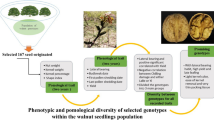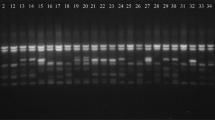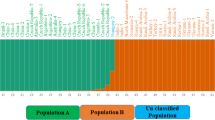Abstract
Arachis pintoi accessions were morphologically characterized using a list of descriptors prepared by IBPGR/ICRISAT. Data from stems, leaves, flowers, pegs, pods, and seeds were collected. Phenotypic correlations were calculated among descriptors, and diversity indices were computed to access the genetic diversity among accessions. Principal component analysis was executed, and a cluster analysis was performed to group the germplasm. The germplasm presented great morphological variability with most of the descriptors showing polymorphism. From 595 correlations computed, 96 were statistically significant. Biologically meaningful correlations (r ≥ 0.71) were found between leaf length and pod weight; leaf length and pod width; leaf length and seed weight; leaf length and seed width; and leaf length and seed length. Diversity values were variable among traits, but in general all morphological features expressed high genetic diversity. Total genetic diversity was estimated as 0.71. Principal component and cluster analysis was able to differentiated four distinct groups.


Similar content being viewed by others
References
Carvalho MA, Quesenberry KH (2003) Arachis pintoi seed production in Florida. In: Proceedings of the 35th APRES annual meeting, Clearwater, FL, APRES
Cook BG, Williams RJ, Wilson GPM (1990) Register of Australian plant cultivars. B. Legumes. 21. Arachis (a) Arachis pintoi Krap. & Greg. nom. nud. (Pinto peanut) cv. Amarillo. Austral J Exp Agricult 30:445–446
De Vries H (1900) Sur la loi de disjunction des hybrides. Comptes Rendus de l’Academie des Sciences (Paris) 130:845–847
IBPGR/ICRISAT (1990) Report of a workshop on genetic resources of wild Arachis species: including preliminary descriptors for Arachis, In: International crop network series 2. IBPGR/ICRISAT, Rome
IBPGR/ICRISAT (1992) Descriptors for groundnut. IBPGR/ICRISAT, Rome
Fernández A, Krapovickas A (1994) Chromosomes and evolution of Arachis (Leguminosae). Bonplandia 8:187–220
Gregory WC, Krapovickas A, Gregory MP (1980) Structure, variation, evolution, and classification in Arachis. In: Summerfield RJ, Bunting AH (eds) Advances in legume science. Royal Botanic Gardens, Kew, pp 469–481
Halward TM, Stalker HT, Larue EA, Kochert G (1991) Genetic variation detectable with molecular markers among unadapted germplasm resources of cultivated peanut and related wild species. Genome 34:1013–1020
Hawkes JG, Maxted N, Ford-Lloyd BV (2000) The ex situ conservation of plant genetic resources. Kluwer, Dordrecht
Krapovickas A, Gregory WC (1994) Taxonomy of the genus Arachis (Leguminosae). Bonplandia 8:1–186
Kochert G, Halward TM, Branch WD, Simpson CE (1991) RFLP variability in peanut (Arachis hypogaea) cultivars and wild species. Theor Appl Genet 81:565–570
Mann J (1987) Secondary metabolism. Oxford University Press, London
Mendel JG (1866) Versuche über Pflanzen-Hybriden. Verhandlungen des naturforschenden Vereines Brünn, Bd. IV, Abhandlungen
Moretzsohn MC, Hopkins MS, Mitchell SE, Kresovich S, Valls JFM, Ferreira ME (2004) Genetic diversity of peanut (Arachis hypogaea L.) and its wild relatives based on the analysis of hypervariable regions of the genome. BMC Pl Biol 4:1–10
SAS Institute Inc (1989) SAS/STAT user’s guide, version 6, 4th edn. SAS Institution Inc, Cary
Shannon CE, Weaver W (1949) The mathematical theory of communication. University of Illinois Press, Urbana
Simpson EH (1949) Measurement of diversity. Nature 163:688
Skinner DZ, Bauchan GR, Auricht G, Hughes S (1999) A Method for the efficient management and utilization of large germplasm collections. Crop Sci 39:1237–1242
Stalker HT (1990) A morphological apprasal of wild species in section Arachis of peanuts. Peanut Sci 17:117–122
Upadhyaya HD, Bramel PJ, Ortiz R, Singh S (2002) Geographical patterns of diversity for morphological and agronomic traits in the groundnut germplasm collection. Euphytica 128:191–204
Upadhyaya HD (2003a) Phenotypic diversity in groundnut (Arachis hypogaea L.) core collection assessed by morphological and agronomical evaluations. Genet Resour Crop Evol 5:539–550
Upadhyaya HD (2003b) Geographical patterns of variation for morphological and agronomic characteristics in the chickpea germplasm collection. Euphytica 123:343–352
Valls JFM, Pizarro EA (1994) Collection of wild Arachis germplasm. In: Kerridge PC, Hardy B (eds) Biology and agronomy of forage Arachis. CIAT, Cali, pp 19–27
Valls JFM, Simpson CE (1994) The taxonomy, natural distribution and attributes of Arachis. In: Kerridge PC, Hardy B (eds) Biology and agronomy of forage Arachis. CIAT, Cali, pp 1–18
Author information
Authors and Affiliations
Corresponding author
Rights and permissions
About this article
Cite this article
Carvalho, M.A., Quesenberry, K.H. Morphological characterization of the USA Arachis pintoi Krap. and Greg. collection. Plant Syst Evol 277, 1–11 (2009). https://doi.org/10.1007/s00606-008-0089-9
Received:
Accepted:
Published:
Issue Date:
DOI: https://doi.org/10.1007/s00606-008-0089-9




